The Development Prospects Of Solar Power Inverter In Thailand
 Sep 24,2024
Sep 24,2024

 XINDUN
XINDUN
As a Southeast Asian country full of sunlight resource, Thailand's solar energy market has developed tremendously. It plays an important role in the market potential of Southeast Asia. The impact of relevant policies on the overseas layout of domestic photovoltaic companies is also worthy of attention. The Thailand solar inverter market has played an important role in the past few years. As key equipment solar system in thailand, the market demand for solar inverter in Thailand has also grown. Next, Xindun will discuss the market and future development prospects of Thailand's solar energy market.
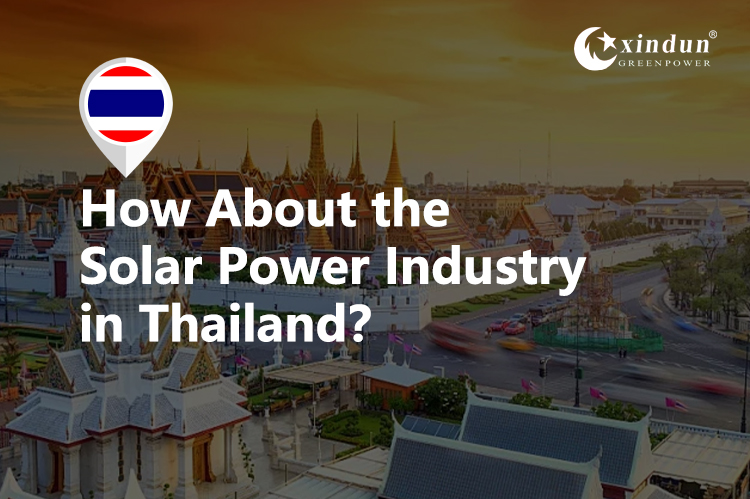
I. Development of Thailand's solar energy industry
Thailand – an important market for green renewable energy
As a developing country in Southeast Asia with a large number of rural areas, Thailand also shows great potential for photovoltaic applications of solar inverter in rural areas. The Thai government's support for solar power projects and the growing awareness of environmental protection have caused more homes and businesses to turn to solar power, thus promoting the growth of solar inverter in the photovoltaic market.
The Thai government regards the development of renewable energy as a national strategy and is committed to increasing the proportion of renewable energy in energy consumption. Further promoting the growth of the solar inverter market and providing more business opportunities for manufacturers and investors, this provides domestic inverter manufacturers with opportunity to expand oversea solar markets.
The market of solar inverter Thailand is in a stage of rapid development, and its market size and demand continue to grow. Government support policies, technological innovation, and international cooperation will further promote market development.
1. How big is the solar energy market in Thailand?
Thailand is one of the important economies in the ASEAN region and the second largest economy in Southeast Asia. According to data from 2023, Thailand's GDP reached 512.193 billion US dollars and its population was about 70 million.
The valuation of Thailand's solar energy market has reached 30 billion baht, mainly concentrated in Bangkok and the central region, mainly for middle and high-income families. It is predicted that about 170,000 homes in Thailand have the need to install solar power systems, which only accounts for 0.8% of the country's 23 million homes. However, Thailand's home solar power market contains hundreds of billions of business opportunities, and at least 2.3 million homes meet the installation conditions. If 20% of them choose to install, a service market worth 137 billion baht will be formed. In addition, Thailand's abundant sunshine resources and reduced costs of key equipment such as solar panels have led more and more families to choose home power supply equipment, especially in the high oil price environment, solar power supply has become a better option to reduce home electricity bills.
2. Geographical conditions and talent cultivation in Thailand
Thailand is located in Southeast Asia and has vast land resources and a population base. Most parts of Thailand have a tropical monsoon climate, characterized by high temperature all year round and distinct dry and wet seasons. Thailand is located near the equator, has long sunshine hours and abundant solar energy resources.
According to statistics, Thailand has sufficient sunlight all year round, with annual radiation of about 1800kW·h/m², and more than half of the areas have a daily radiation of 5.00–5.28kW·h/m². The acceptance of the solar and energy storage markets is very high.
In terms of investment in educational resources, the Thai government keeps up with the international perspective and devotes sufficient resources to talent cultivation. This provides good condition and foundation for the localized construction and operation of solar power projects.
At the same time, Thailand has a good connection with the international market, and has a high degree of acceptance of international cutting-edge technology and various resource information, which is more conducive to the introduction of high-tech technology and funds to develop a localized photovoltaic industry. Among the top ten countries in China's solar power exports in the first quarter of 2023, Thailand ranked fourth with US$655 million, ranking first in Asia.
3. Thailand's electricity and solar storage policies
As one of the largest electricity markets in Southeast Asia, Thailand's electricity consumption reached 222 terawatt hours in 2022. With the rapid development of Thailand's industry, electricity demand has also shown a rapid growth trend. Among them, industrial electricity consumption accounts for the largest share, about 47.4%, followed by commercial electricity, residential electricity and agricultural electricity. The electricity consumption in industrial sectors such as government and non-profit sectors is relatively small.
According to the forecast of Thailand's medium and long-term GDP, population, per capita electricity consumption, electricity elasticity coefficient and other factors, electricity demand is expected to grow at an average annual rate of 2.3%. It is expected that by 2050, electricity demand will reach 403 terawatt hours (about 40.3 billion kwh).
The "2023-2027 Thailand Renewable Energy Market In-depth Research and Analysis Report" pointed out that in recent years, the Thai government has been committed to reducing its dependence on traditional energy and promoting the development of clean energy. To achieve this goal, the government has introduced a series of policies to encourage private and corporate investment in renewable energy.
For example, the Thai government has also implemented a "green certificate" program to encourage the development of renewable energy. The program allows renewable energy power stations to apply for "green certificates", each certificate represents 1 megawatt-hour of renewable energy power. These certificates can be sold on the market to companies or individual who need certificates to encourage more people to use renewable energy. In 2021 (COP 26 Glasgow 2021), the Thai government has vigorously promoted the work of the National Energy Master Plan, striving to achieve the "carbon neutrality" goal in 2050 and achieve net zero carbon emissions in 2065.
According to the regulations of the Thai government, eligible solar power system can enjoy renewable energy power subsidies, known as FIT subsidies. For solar power projects, the subsidy amount per kilowatt-hour is 2.1679 baht, and the subsidy period is 25 years. For light storage power projects, the subsidy amount per kilowatt-hour is 2.8331 baht, and the subsidy period is also 25 years. The implementation of these subsidy policies is aimed at encouraging the development and utilization of renewable energy and promoting Thailand's transition to green energy.
4. The latest solar energy policy in Thailand in 2024
In order to promote the development of the solar energy market, the Thai government actively encourages the public to use solar energy. The Thai government has taken a series of positive measures to promote the development of the solar energy industry in Thailand. Since 2019, the "Residential Photovoltaic Program" has been launched, allowing general residential electricity users to install solar panels on their roofs to generate electricity for their own use, and can sell excess electricity to the national power company.
According to recent Thai media report, the Department of Alternative Energy Development (DEDE) of Thailand said that a new tax reduction plan for home installing rooftop solar panels is expected to be finalized in the middle of the year to reduce electricity bill and carbon dioxide emission. DEDE said that home that purchase solar panels with a power capacity of less than 10 kilowatts at price below 200,000 baht can participate in the plan. The tax reduction calculation will be determined by the Thai Tax Bureau. DEDE expects that 90,000 homes will participate from this year to next year. The plan requires a budget of 20.2 billion baht and can reduce electricity consumption by 585 million kilowatt-hours per year.
Thailand is pushing for energy transformation and diversified development. Clean and renewable energy has accounted for nearly 30% of the country's total power, with biomass power accounting for the majority, followed by hydropower, solar energy in third place, and wind energy in fourth place. The Prime Minister of Thailand said at the 2024 Sustainable Development Forum that Thailand is formulating a power development plan with the goal of increasing the proportion of clean and renewable energy in the country's total power to 50%, while ensuring electrical stability and reducing electricity costs.
5. Thailand's solar energy market has a promising future
Growth trend: The growth trend of Thailand's solar energy storage market is indeed very obvious. Government support policies, declining costs, and increasingly serious energy shortage have prompted more and more home to consider and use solar energy storage system. This trend has continued to strengthen in recent years and is expected to continue to grow in the next few years.
Government support: The Thai government has made a lot of efforts to promote the development of renewable energy. They encourage homes to install solar power system by providing incentives such as subsidies and tax breaks. These policies not only reduce the cost of solar power system, but also provide more attractive investment opportunities for home users. However, it should be noted that despite the government's support, the specific subsidy intensity and policy details may change over time and policy changes. Therefore, before entering the Thai market, it is necessary to conduct in-depth investigation and research on local policies.
Low penetration: Although the solar energy storage market is gradually growing in Thailand, the penetration rate is still relatively low. This may be because some home users are not yet aware of and accept solar energy storage system, or because some users have concerns about the cost and complexity of installing and using solar energy system. Therefore, improving the public's awareness and acceptance of solar energy storage system, as well as reducing installation and use costs are the key to promoting further market penetration.
Self-power and self-use: With the development of solar energy storage system technology and the reduction of costs, more and more families are beginning to consider using solar energy systems to meet their energy needs. This self-power and self-use model can not only reduce dependence on traditional energy, but also bring energy cost savings and environmental protection advantage to home users. Therefore, providing solar energy storage system and related service suitable for home use is an important direction for future market development.
Overall, the development trend of Thailand's solar market is strong, and factors such as government support, technological progress and cost reduction have all driven market growth. At the same time, as the Thai public's awareness and acceptance of solar energy systems increases, as well as the cost of installation and use decreases, it is expected that Thailand's solar energy storage market will continue to expand in the next few years, and the market is promising in the future.
Ⅱ.Types of Solar Inverter
Solar inverter is an indispensable and important part of solar power system. Solar inverter is a type of power conversion equipment that is mainly responsible for converting the direct current generated by solar panels into alternating current to meet the needs of household, industrial and commercial electricity.
Solar inverter can be divided into three types according to the usage scenarios, namely off grid solar inverter, on grid solar inverter and hybrid solar inverter. These three types of solar inverter have their own characteristics, advantages and applicable scenarios. How to choose a solar inverter suitable for your own use requires a better understanding of the functions and characteristics of these three types of solar inverter.
1. Off grid solar inverter
Off grid solar inverter is an inverter specially used for off grid solar power system, which converts DC into AC for power supply load.
Off grid solar inverter has the characteristics of stable AC output and can store excess power for emergency use. The advantage of off grid solar inverter is that it is suitable for remote areas or scenes without access to the power grid, and can provide reliable power supply.
Off grid inverter is generally suitable for remote areas or places without power grid power supply, such as mountainous areas, deserts, islands, etc. Off grid solar inverter can provide reliable power supply for these areas to meet basic living and working needs. Off grid solar inverter can also be used as a backup power supply to deal with sudden power outage or disaster.
2. On grid solar inverter
On grid solar inverter is an inverter that converts DC generated by solar panels into AC and can be connected to the power grid. It can inject the power generated by the solar power system into the public power grid to achieve interconnection with the power grid.
Features of on grid solar inverter It has grid detection and protection functions to ensure safe and reliable on grid power. Advantages of on grid solar inverter, it can sell excess solar power to the grid to achieve two-way flow of power, and it can also obtain power from the grid to supplement the insufficient solar power.
On grid solar inverter is suitable for areas with grid power supply to sell power to the grid to achieve economic benefits. It is applicable to both home and commercial use. For home use, such as rural household, excess power can be sold to the grid to achieve self-sufficiency, energy conservation and emission reduction, and economic benefits. Enterprises can also sell power to the grid for commercial use to obtain benefits and reduce their energy costs and environmental pollution.
3. Hybrid solar inverter
Hybrid solar inverter is an inverter that has both off grid and on grid functions. It can convert the DC power generated by solar panels into AC power for use, and can also convert grid power into DC power for storage. It can switch between off grid and on grid operation modes of solar power system. In the on grid mode, it can sell power to the grid to earn income, and has a mains charging function to charge the battery.
Feature of hybrid solar inverter: It has a bidirectional current flow function, which can realize the mutual complementation and switching of solar energy and the grid to meet the needs of different loads, and can achieve the purpose of self-power and self-use, and surplus power to the grid, so as to maximize the utilization of solar power.
Advantage of hybrid inverter: It can realize dual power supply of solar energy and grid when there is grid power supply, improve energy utilization efficiency, and provide backup power supply in the event of power outage through solar energy storage function.
Hybrid solar inverter is suitable for areas with unstable power supply. They can provide stable power supply through energy storage function to ensure the normal operation of load equipment. For example, rural households can sell the stored excess power to the grid in addition to meeting their own needs, which can not only ensure their own power supply but also earn income.
4. Recommended Thailand Xindun Solar Inverter
Inverter is a device that converts DC generated by solar panels or batteries into AC. It plays the role of "brain" in the solar power system, responsible for managing, monitoring and optimizing the operation of the solar power system. The performance of the inverter directly affects the power efficiency and stability of the solar power system, so choosing a high quality inverter is crucial to the operation of the solar power system.
Inverter Selection Guide
Xindun solar inverter products are also popular among Thai customers in the Thai market. Xindun has many different types of solar inverter products. Here are some new and popular solar inverter products recommended by Xindun:
1. Xindun HF High Frequency Hybrid Solar Inverter
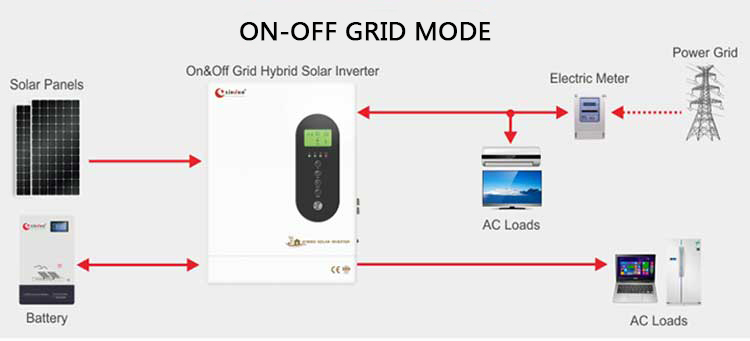
Xindun HF high frequency on grid and off grid hybrid solar inverter 5kw-12kw, DC 48V/96V/192V/240V to AC 220V/230V/240V
With power specifications of 5kw-12kw, it provides DC 48V to AC 220V/230V/240V, 5kw/6kw/8kw/10kw/12kw power specifications are optional. Xindun HF is on grid off grid hybrid solar inverter, which gives priority to solar energy. When solar power energy is surplus, it is stored in batteries or send to the grid. When solar power energy is insufficient, it is supplemented by the mains or batteries for load use. Realize the maximum utilization of solar power to achieve the purpose of self-power and self-use, and sell excess electricity back to the grid.
Xindun HF high frequency on grid and off grid hybrid solar inverter has the following functions and advantages:
1. High Efficiency and Compact Design: Utilizes a high-frequency design for high power density, resulting in a smaller size and increased overall efficiency.
2. Bidirectional Energy Storage: Supports bidirectional energy flow control, allowing both photovoltaic (PV) and mains electricity to charge the battery.
3. Pure Sine Wave Output: Pure sine wave output that is compatible with a wide range of loads.
4. Wide MPPT Range: Features an ultra-wide Maximum Power Point Tracking (MPPT) range, with a minimum input voltage as low as 80Vdc.
5. Adjustable Charging and Discharging Parameters: Allows for customizable charging and discharging voltage settings to match various battery types, enhancing battery lifespan and system performance.
6. Flexible Battery Configuration: Users can set the battery charging current to accommodate different battery capacities, offering greater flexibility.
7. Selectable Operating Modes: Offers multiple operating modes including on-grid, off-grid, and hybrid modes.
8. Output Priority Settings: Provides options for setting output priorities, such as mains priority, PV priority, or battery priority.
9. Charging Priority Settings: Allows for setting charging priorities, including simultaneous PV and mains charging, PV-only charging, or PV priority charging.
10. Battery-Less Operation: Capable of operating without a battery and supports lithium battery BMS communication.
11. Adjustable Output Voltage/Frequency: Features settings for output voltage and frequency to adapt to different power grid environments.
12. Advanced Monitoring and Communication: Supports RS485 communication, dry contact signals, and mobile phone app monitoring via WIFI/GPRS.
13. Smart Meter Support: Optional smart meter integration for anti-backflow protection during on-grid operation.
2. Xindun ESS-Li All In One Solar Power Generator
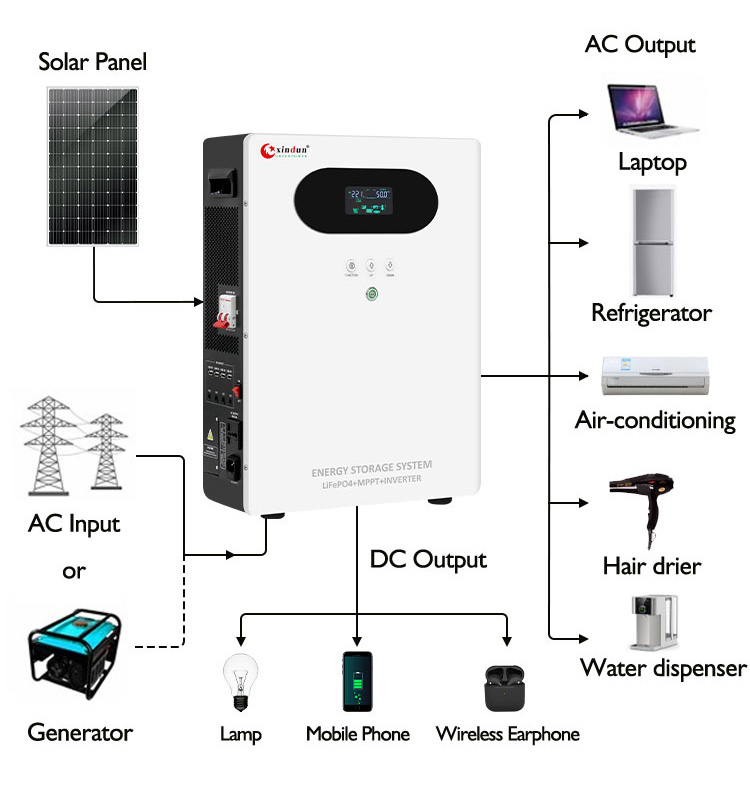
Xindun ESS-Li all in one solar power generator 300w-7000w, DC 12V/24V/48V to AC 110V/120V/220V/230V/240V
If you want to find a portable, plug-and-play, easy-to-install solar generator, then Xindun would like to introduce you to the Xindun ESS-Li solar generator. The Xindun ESS-Li all in one solar generator is combine solar controller, inverter, and battery all in one. The solar generator can convert solar energy into electrical energy and store it in the battery. It can meet the needs of users for home or commercial use, and has an interface output for DC output. It has a power specification of 300w-7000w, provides DC 12V/24V/48V to AC 110V/120V/220V/230V/240V, and has 300w/600w/1200w/2200w/3000w/5000w/6000w/7000w power specifications.
Xindun ESS all in one solar power generator has the following functions and advantages:
1. All in one design: The solar generator include solar controller, inverter and battery all in one, which simplifies the installation and use process of the system and is more convenient to use.
2. Strong carrying capacity: 3 times the peak power, with strong carrying capacity, suitable for various equipment and load requirements.
3. Stable and reliable: It adopts pure sine wave output, provides strong stable output capacity, and ensures the stable operation of the equipment.
4. Efficient energy storage: Compatible LiFePO4 battery, charging is faster and more energy can be stored efficiently.
5. Multiple output type interfaces: Support AC and DC USB sockets (5V, 12V) output to meet the output interfaces of different devices.
6. Multiple working modes: You can choose AC priority, ECO energy-saving mode or photovoltaic priority mode. Users can switch and adjust according to their needs to flexibly adapt to various scenarios.
7. Adjustable charging current: The AC charging current can be set in the range of 0-30A, and users can adjust it according to actual operation.
8. Visual control: Equipped with LCD+LED display, the operating data is clear at a glance, the operation is simple, easy to use, and the operating status of the system can be understood more intuitively.
9. Multiple protection functions: such as undervoltage, overvoltage, overload, overtemperature, short circuit and other protections to ensure the safe operation of the equipment. It also has a battery BMS report, which provides comprehensive protection and always protects your power safety, making you feel more at ease when using electrical equipment.
3.Xindun LF Low Frequency Solar Inverter
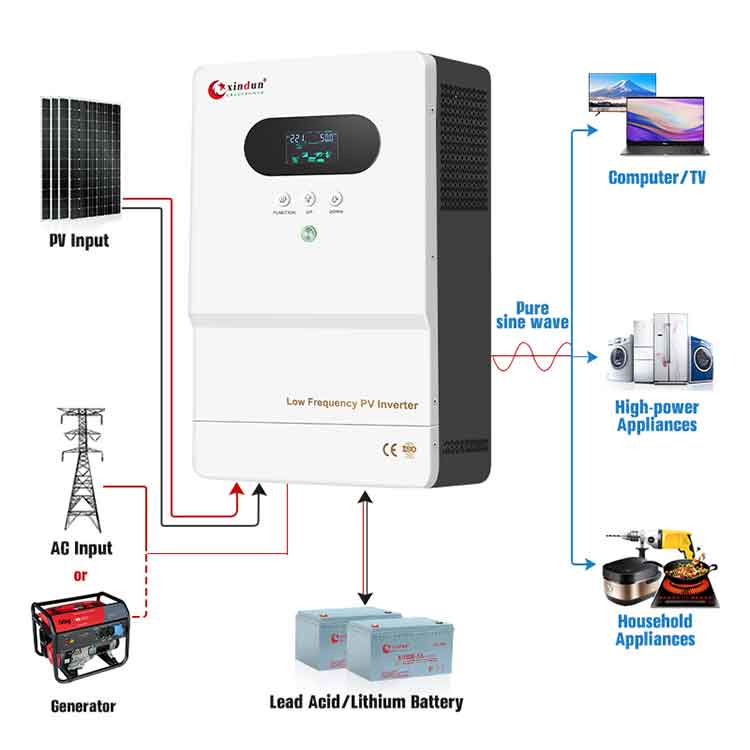
Xindun LF low frequency solar inverter 1kw-12kw, DC 12V/24V/48V to AC 110V/120V/220V/230V/240V
Xindun LF low frequency solar inverter has a power specification of 1kw-12w. Xindun LF low frequency solar inverter is a high-performance solar inverter with dual voltage switching output and pure sine wave output. It provides DC 12V/24V/48V to AC 110V/120V/220V/230V/240V. It has 110V/120V/220V/230V/ 240V different voltage switching is optional, and the inverter output frequency is 50/60Hz±1% switching. It can meet the voltage standards of different countries and regions, and has 1000w / 1500w / 2000w / 4000w / 5000w / 6000w / 8000w / 10kw / 12kw power specifications.
Xindun LF solar inverter has the following functions and features:
1. High efficiency and energy saving: It adopts a toroidal low-loss transformer with high inverter efficiency, which can achieve high efficiency and energy saving, and has pure sine wave output to ensure stable power quality.
2. Dual voltage output: It has dual voltage switching output function, which can adapt to different power grid environments, and the output voltage and frequency can be set to meet the needs of different loads.
3. Intelligent display: It adopts intelligent LCD integrated display to facilitate users to monitor the operating status and parameters of the inverter in real time.
4. New appearance design: The appearance design is fashionable and beautiful, and it can be built-in PWM or MPPT controller to meet the needs of different application scenarios.
5. Multiple working modes: With three working modes to choose from, the mains charging current is adjustable from 0 to 30A, and it supports diesel (gasoline) generator, which can be used in harsh power environment.
6. Automatic protection function: With fully automatic and perfect protection function, the starting peak power is more than 3 times, and it can automatically shut down for protection under various abnormal conditions to ensure the safety of equipment and user.
7. Remote monitoring and management: Support RS485/mobile app remote monitoring and management, realize remote monitoring and management, and provide a more convenient user experience.
8. Fault code query: Added fault code query function, which is convenient for users to monitor the operating status of the inverter in real time and handle faults in time.
9. Both industrial and civil use: The inverter is suitable for industrial and civil field, with wall mounted design, easy installation, and can be widely used in various places.
4. Xindun HP PRO-T solar inverter

Xindun HP PRO-T solar inverter 1000w-8000w, DC 12V/24V/48V to AC 220V/230V/240V
Xindun HP PRO-T solar inverter has a power specification of 1000w-8000w. Xindun HP PRO-T solar inverter is a high-efficiency and stable home inverter, providing DC 12V/24V/48V to AC 220V/230V/240V, 50Hz/60Hz, with 1000w/1500w/2000w/3200w/5000w/7200w/8000w power specifications optional.
Xindun HP PRO-T solar inverter has the following functions and features:
1. High efficiency and energy saving: adopts high-frequency design, small size, high overall efficiency, small no-load loss, and energy saving.
2. Multifunctional integrated design: built-in MPPT controller, solar charging, control, inverter, and mains complementary integrated design, convenient and easy to use.
3. Adapt to various loads: pure sine wave output, can adapt to various types of loads, to ensure the stable operation of electrical equipment.
4. Flexible configuration: with charging voltage setting function, different battery types and capacities can be used, flexible configuration to meet user needs.
5. Multiple working modes can be set: mains priority, battery priority, photovoltaic priority and other working modes can be set according to needs.
6. Adapt to different power grid environments: with the function of setting output voltage and frequency, adapt to the use of different power grid environment.
7. Support for multiple input sources: support mains or generator input, adapt to different application occasions, and provide more flexibility of use.
8. Simple and intuitive operation: LED+LCD display, simple and intuitive operation interface, clear operation data at a glance, more convenient user experience.
9. Multiple protection functions: with multiple protection functions, such as overload, temperature, short circuit protection, etc., to ensure the safety of equipment and users.
10. Remote monitoring and management: Support RS485/mobile app remote monitoring and management, convenient for real-time control and maintenance.
6. Xindun HP PLUS+ Hybrid Solar Inverter
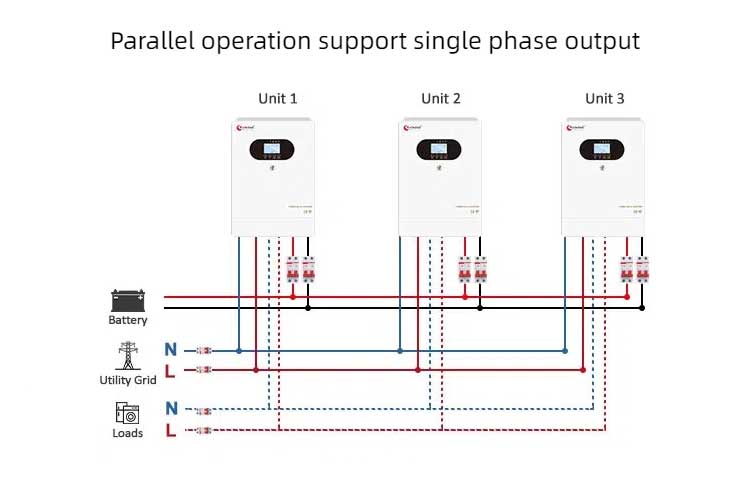
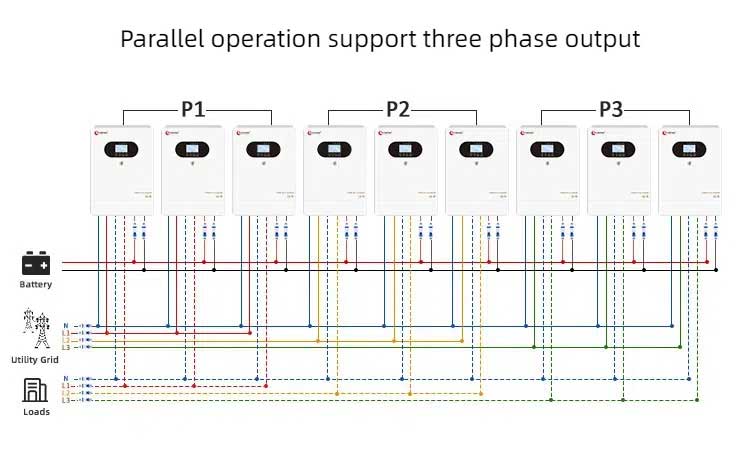
Xindun HP PLUS+ Hybrid Solar Inverter 5000w, DC 48V to AC 208V/220V/230V/240V
If you want to find an inverter with parallel function, Xindun will introduce you to a Xindun HP PLUS+ hybrid solar inverter. Xindun HP PLUS+ Hybrid Solar Inverter is an off grid high frequency solar inverter with parallel function, providing DC 48V to AC 208V/220V/230V/240V, single-unit capacity of 5000w, up to 9 units can be operated in parallel, single-unit capacity of 5000w can be expanded to 10KW/15KW/20KW/25KW/30KW/35KW/40KW/45KW.
The following are the functions and features of Xindun HP PLUS+ hybrid solar inverter:
1. Efficient energy conversion: adopts high-frequency design to provide higher conversion efficiency and reduce no-load loss, thereby improving energy utilization efficiency.
2. Pure sine wave output: The inverter adopts pure sine wave output to ensure that your load equipment is stably and reliably supplied with electricity, without worrying about power quality issues.
3. Multi-energy power supply: hybrid charging of solar energy and mains electricity, intelligent allocation, and flexible energy management solutions.
4. Intelligent operation and monitoring: Through the LED+LCD display, you can understand the operating status of the system more intuitively. Equipped with intelligent LCD settings, the operation is simple and convenient. Users can set the working mode, charging current, charging voltage, AC output voltage/frequency and other parameters according to their needs.
5. Multiple protection functions: It has multiple protection functions, including overload protection, over-temperature protection, short-circuit protection, etc., to ensure the safe operation of the system and load equipment, so that you can use it with confidence.
6. Flexible system expansion: Flexible system expansion capability, supports up to 9 inverters in parallel operation, and the single-unit capacity can be expanded to 45kw to meet your needs of different scales.
7. Remote monitoring and management: Supports USB/RS232/mobile phone APP/WIFI/GPRS and other communication, allowing you to remotely monitor the system through mobile phone APP or computer anytime, anywhere, and always control the system operation status.
Ⅲ.Xindun Power Inverter Manufacturer
Founded in 2006, Xindun Power is an inverter manufacturer focusing on the research, development, design, production and sales of inverter, solar controller, solar power system, etc. Xindun Power is committed to providing global users with stable, reliable, high-quality solar inverter power products.
With a wide range of different types of inverter, such as on grid and off grid hybrid solar inverter, high frequency solar inverter, all in one solar generator,etc. Xindun is able to meet the various needs of customers in Thailand. Xindun not only provides off-the-shelf inverters, solar controllers and solar power systems, but also provides customized service. We can make OEM customization, including appearance design, logo design, voltage, power and other special parameters, in order to be able to meet the product needs of different customers in Thailand and even around the world.
Xindun Power's products are exported to more than 100 countries and regions to meet the needs of global consumers for a variety of solar inverter power products. We have also established long-term business relationships with Southeast Asia, the Middle East, Africa, and Latin America. Among them, Xindun Power Supply has set up branches and marketing centre and warehouses in East Africa, West Africa, South Asia and Southeast Asia to provide sales and services in overseas regions.
As a professional inverter manufacturer, Xindun, our inverter products features have high efficiency, high stability, long service life, etc. We are able to meet the demand for solar power in different scales and applications, and provide high quality solar inverter products and solar energy solutions for users in Thailand. If you want to purchase or know more about Xindun solar inverter, please Log in http://www.xinduninverter.com.
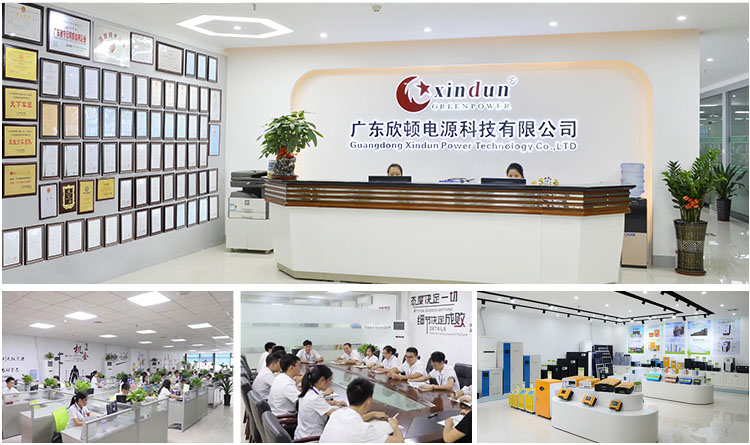
IV. Installation and maintenance of inverter
After selecting the solar inverter, then it is to install the solar inverter, when installing the inverter, users need to install it according to the steps and precautions of the manual to ensure its normal operation and safety. And the future maintenance of the inverter is also need to pay attention to maintenance.
Before installing the solar inverter, it should be fully inspected to ensure that it is intact and meets the installation requirements. During the installation process, according to the steps in the manual, choose the appropriate installation position and installation method. During installation, attention should be paid to the ventilation and heat dissipation of the inverter to avoid it being affected by too high temperature.
When installing the inverter, it should be wired correctly. Before wiring, the wiring diagram and manual of the inverter should be understood to ensure the correctness and safety of wiring. During the wiring process, attention should be paid to the tightening and anti-loosening measures of the wiring to avoid loose or detached wiring leading to safety accidents.
The maintenance of the inverter is equally important. The normal operation of the inverter requires regular maintenance and inspection to ensure its performance and safety. During the maintenance process, the parameters of the inverter should be monitored and analyse, and abnormalities should be found and dealt with in a timely manner. At the same time, the heat dissipation system and electrical components of the inverter should also be checked and maintained to ensure its normal operation and life.
Users for inverter maintenance work, need to have certain professional knowledge and skills, according to the manual or contact the manufacturer's technical personnel to carry out maintenance work.
Installation and maintenance of the inverter is an important part of ensuring the stable operation of the power system. In the installation process, certain steps and precautions need to be followed to ensure its normal operation and safety. In the maintenance process, it is necessary to carry out regular inspection and maintenance, timely detection and treatment of abnormalities to ensure the performance and safety of the inverter. At the same time, for the maintenance personnel, it is also necessary to continuously improve their professional knowledge and skill level, in order to better serve the installation and maintenance of inverters.

 Solar Inverter
Solar Inverter





 Hybrid Inverter
Hybrid Inverter
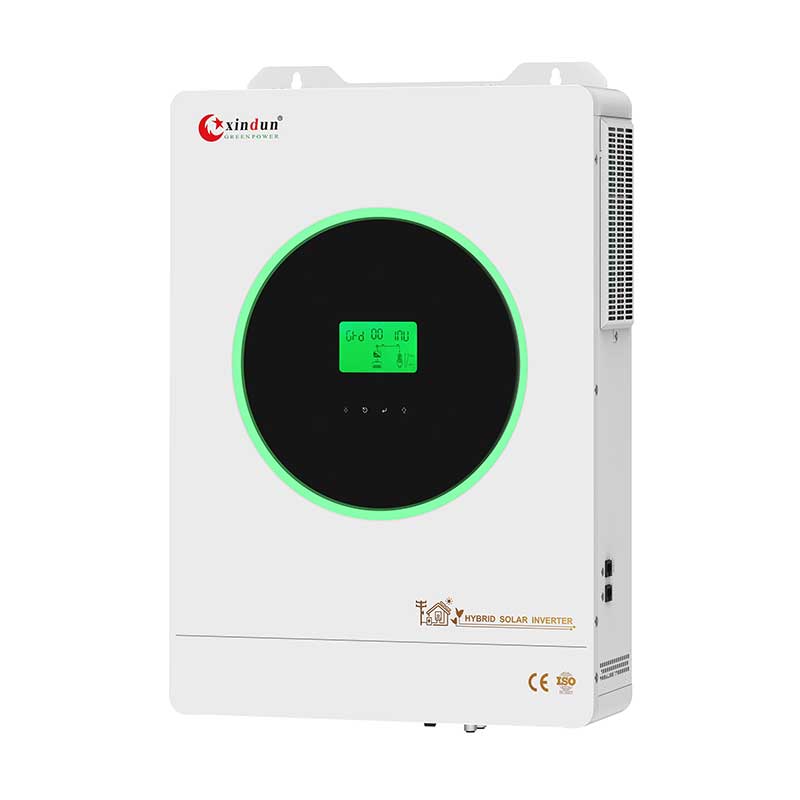
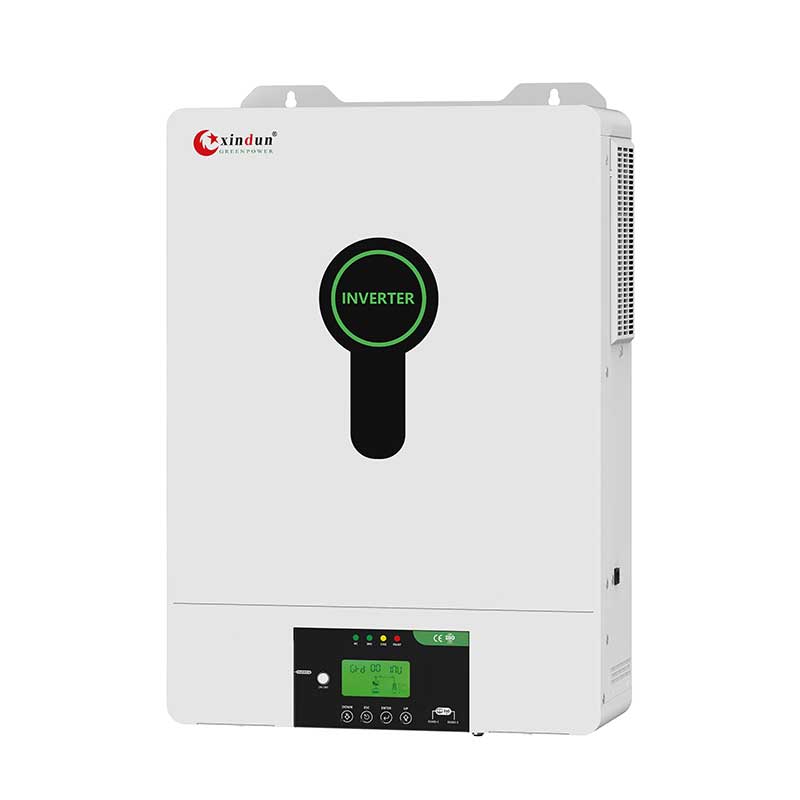


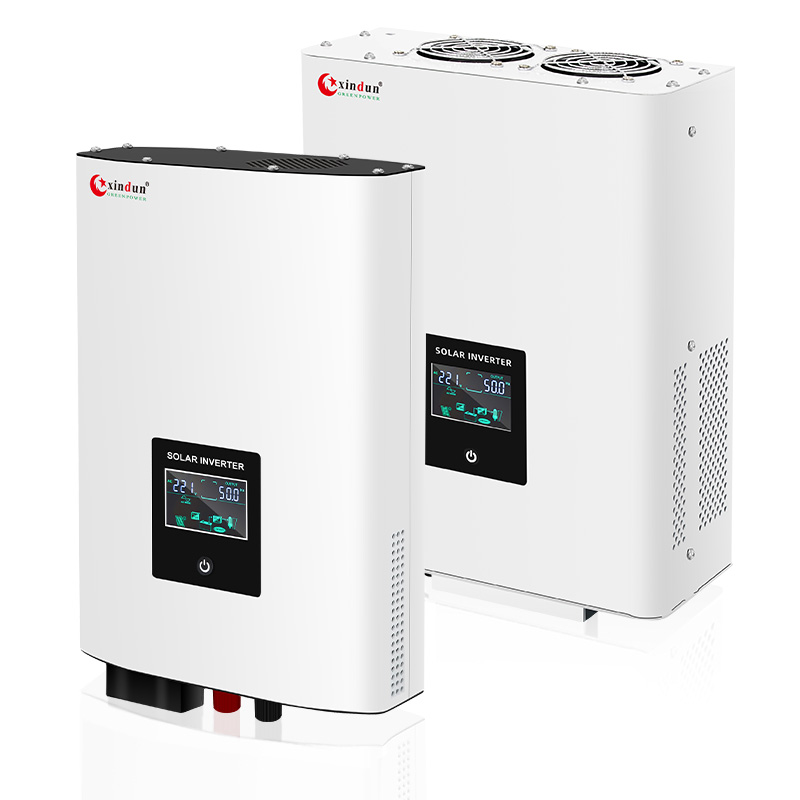
 Power Inverter
Power Inverter
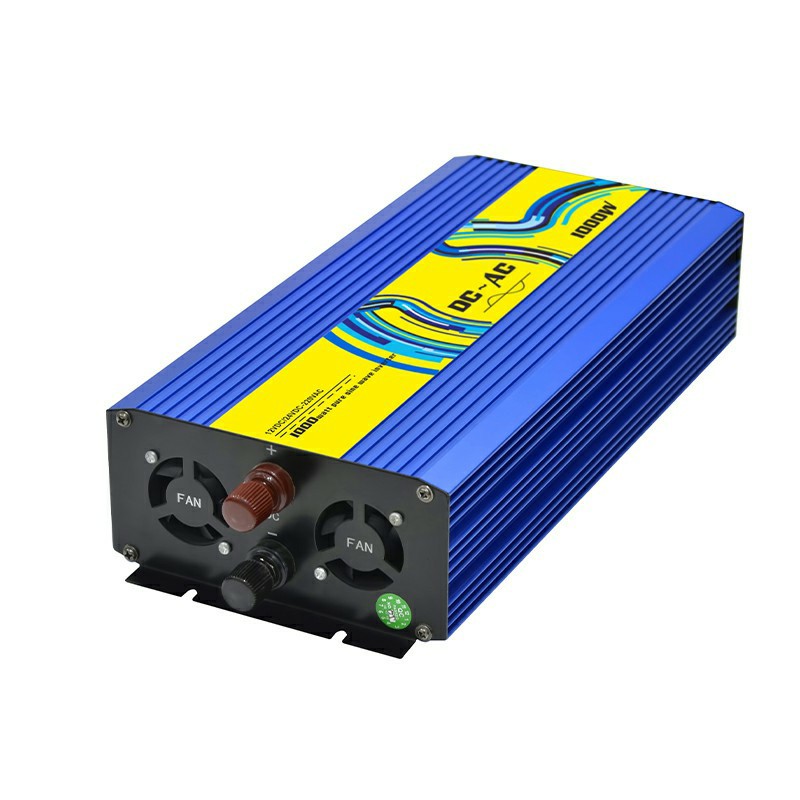


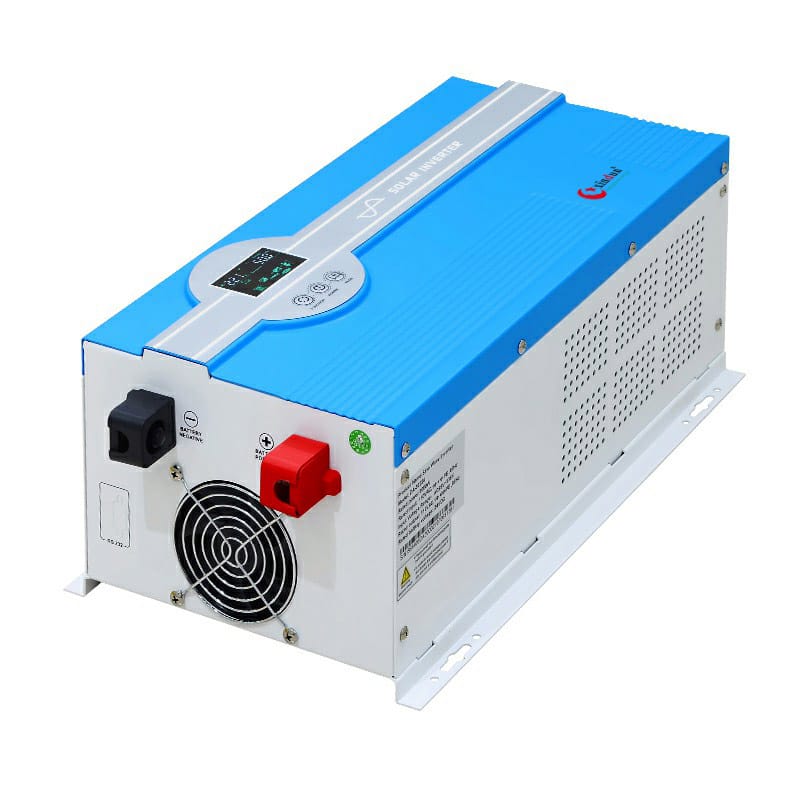
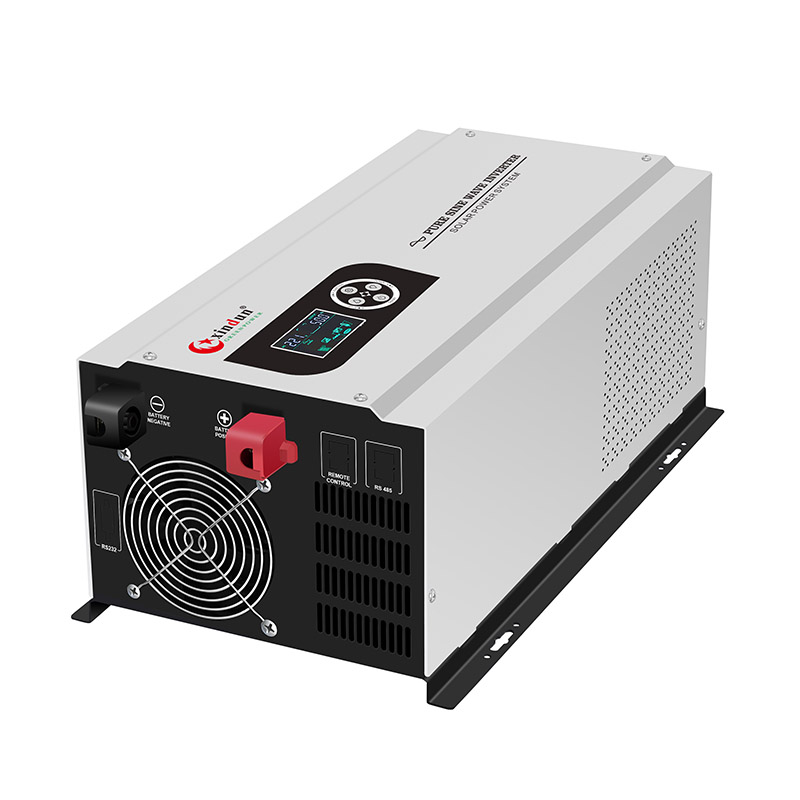
 Split Phase Inverter
Split Phase Inverter

 Energy Storage Inverter
Energy Storage Inverter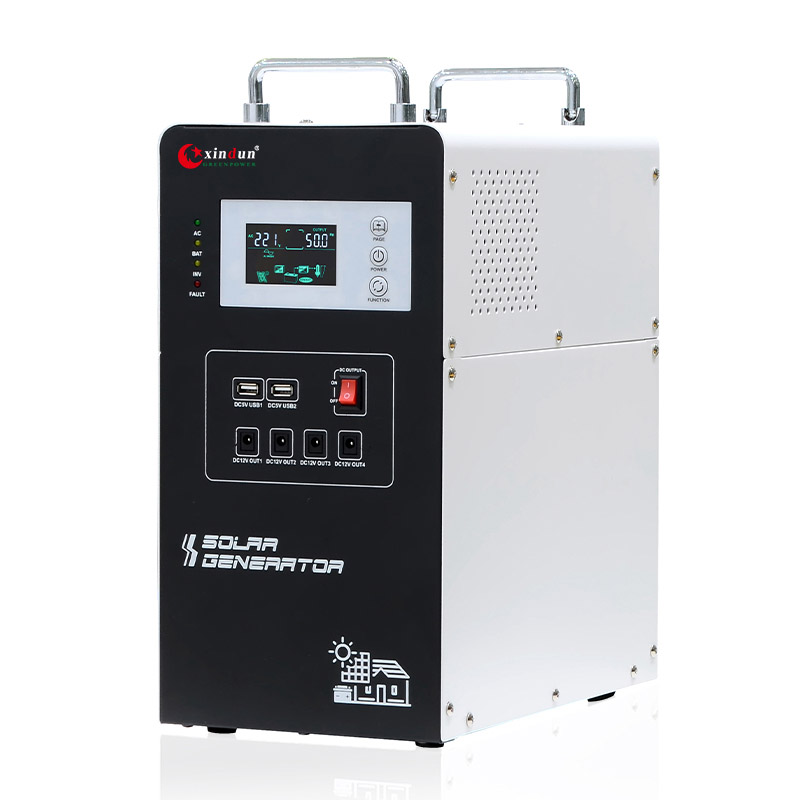




 3 Phase Inverter
3 Phase Inverter
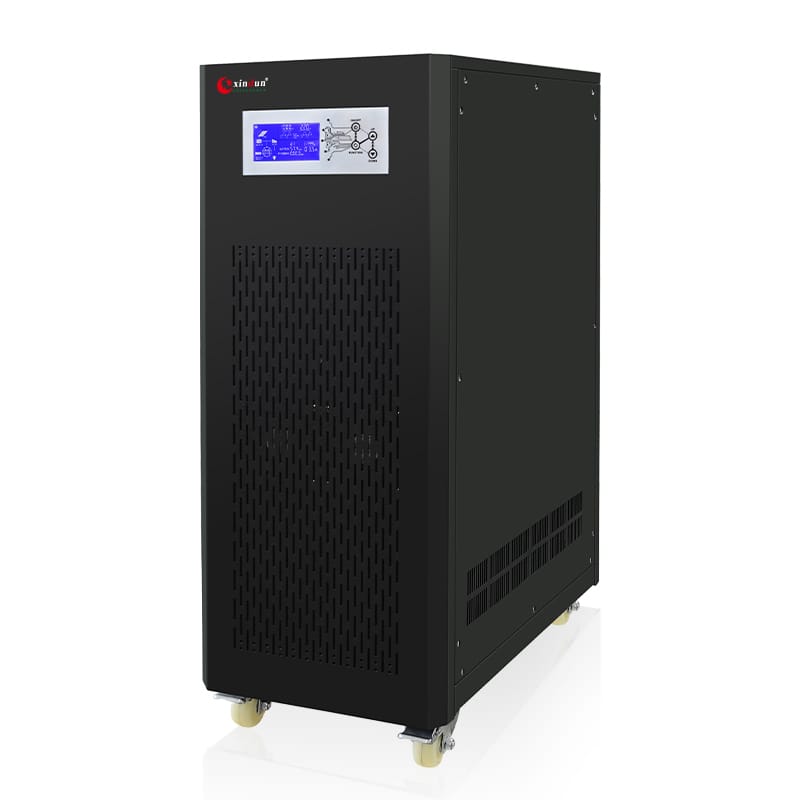



 Solar System Kits
Solar System Kits





 Solar Charge Controller
Solar Charge Controller
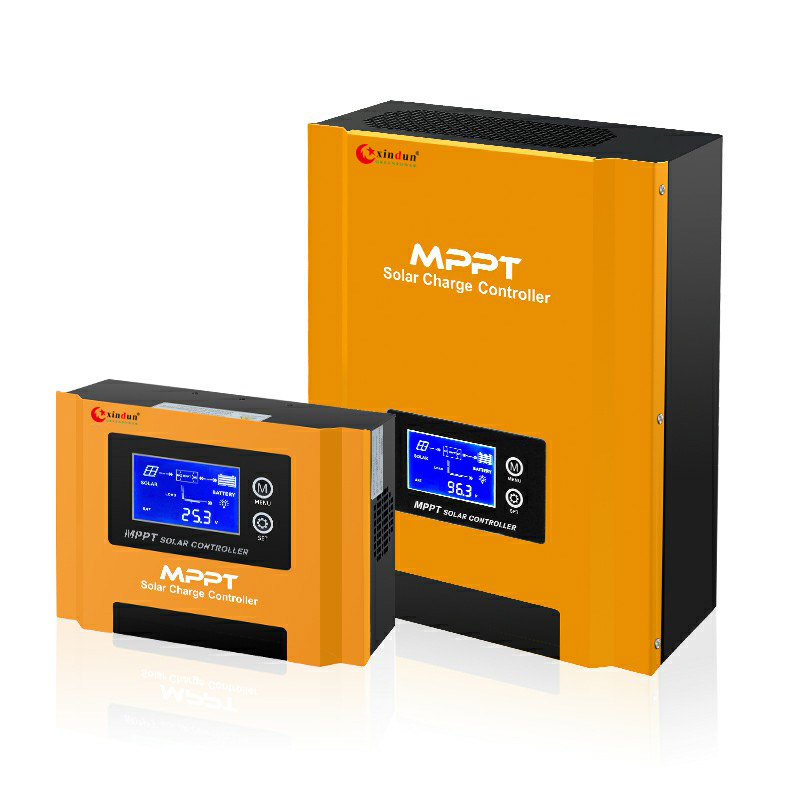

 Solar Battery
Solar Battery



 Asia
Asia
 Africa
Africa



 South America
South America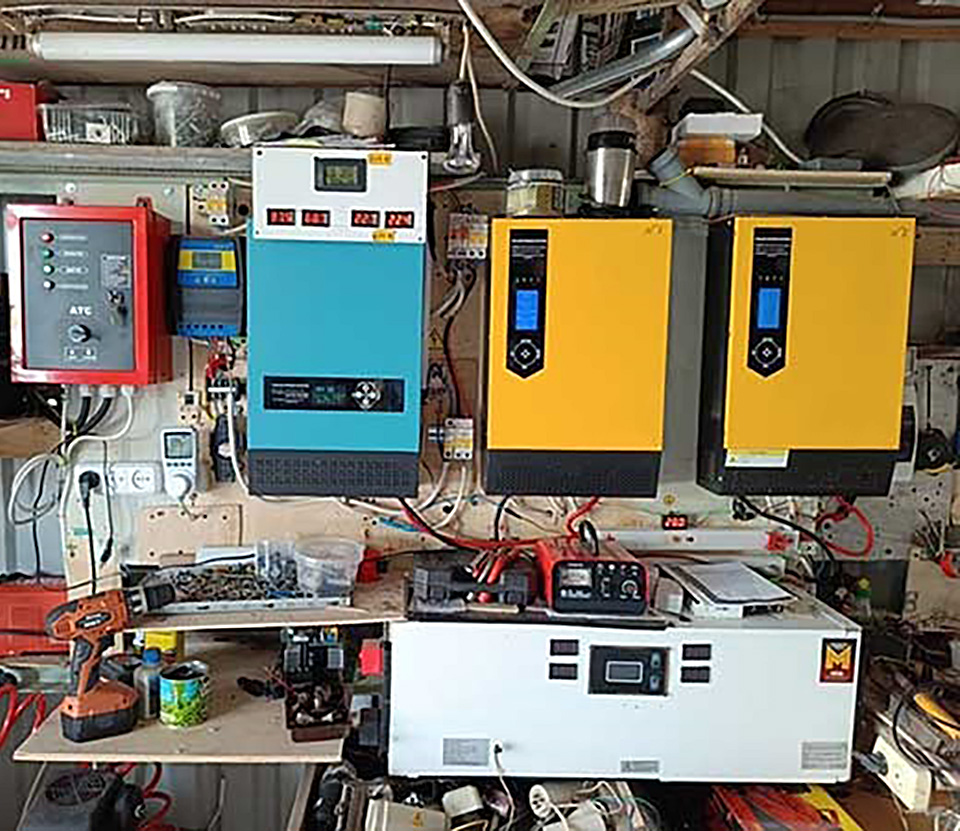
 Europe
Europe

 North America
North America

 Oceania & Antarctica
Oceania & Antarctica










 Home
Home Development Trends Of Solar Power Inverter System In The Iran Market
Development Trends Of Solar Power Inverter System In The Iran Market  Top Selling Products
Top Selling Products














